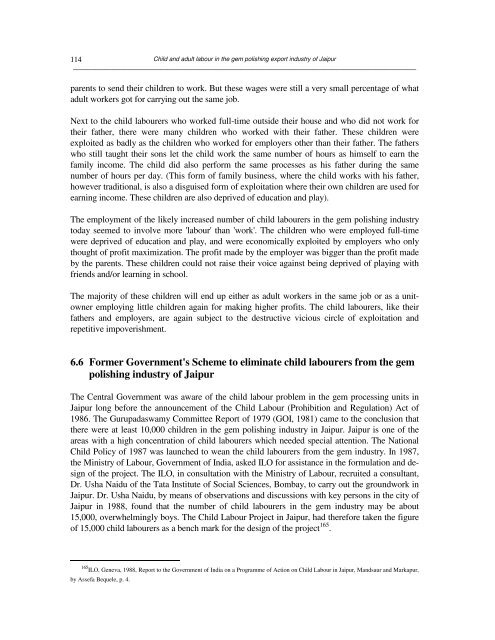You also want an ePaper? Increase the reach of your titles
YUMPU automatically turns print PDFs into web optimized ePapers that Google loves.
114<br />
<strong>Child</strong> <strong>and</strong> <strong>adult</strong> <strong>labour</strong> <strong>in</strong> <strong>the</strong> <strong>gem</strong> polish<strong>in</strong>g <strong>export</strong> <strong>in</strong>dustry <strong>of</strong> Jaipur<br />
──────────────────────────────────────────────────────────────────────────────────────────────<br />
parents to send <strong>the</strong>ir children to work. But <strong>the</strong>se wages were still a very small percentage <strong>of</strong> what<br />
<strong>adult</strong> workers got for carry<strong>in</strong>g out <strong>the</strong> same job.<br />
Next to <strong>the</strong> child <strong>labour</strong>ers who worked full-time outside <strong>the</strong>ir house <strong>and</strong> who did not work for<br />
<strong>the</strong>ir fa<strong>the</strong>r, <strong>the</strong>re were many children who worked with <strong>the</strong>ir fa<strong>the</strong>r. These children were<br />
exploited as badly as <strong>the</strong> children who worked for employers o<strong>the</strong>r than <strong>the</strong>ir fa<strong>the</strong>r. The fa<strong>the</strong>rs<br />
who still taught <strong>the</strong>ir sons let <strong>the</strong> child work <strong>the</strong> same number <strong>of</strong> hours as himself to earn <strong>the</strong><br />
family <strong>in</strong>come. The child did also perform <strong>the</strong> same processes as his fa<strong>the</strong>r dur<strong>in</strong>g <strong>the</strong> same<br />
number <strong>of</strong> hours per day. (This form <strong>of</strong> family bus<strong>in</strong>ess, where <strong>the</strong> child works with his fa<strong>the</strong>r,<br />
however traditional, is also a disguised form <strong>of</strong> exploitation where <strong>the</strong>ir own children are used for<br />
earn<strong>in</strong>g <strong>in</strong>come. These children are also deprived <strong>of</strong> education <strong>and</strong> play).<br />
The employment <strong>of</strong> <strong>the</strong> likely <strong>in</strong>creased number <strong>of</strong> child <strong>labour</strong>ers <strong>in</strong> <strong>the</strong> <strong>gem</strong> polish<strong>in</strong>g <strong>in</strong>dustry<br />
today seemed to <strong>in</strong>volve more '<strong>labour</strong>' than 'work'. The children who were employed full-time<br />
were deprived <strong>of</strong> education <strong>and</strong> play, <strong>and</strong> were economically exploited by employers who only<br />
thought <strong>of</strong> pr<strong>of</strong>it maximization. The pr<strong>of</strong>it made by <strong>the</strong> employer was bigger than <strong>the</strong> pr<strong>of</strong>it made<br />
by <strong>the</strong> parents. These children could not raise <strong>the</strong>ir voice aga<strong>in</strong>st be<strong>in</strong>g deprived <strong>of</strong> play<strong>in</strong>g with<br />
friends <strong>and</strong>/or learn<strong>in</strong>g <strong>in</strong> school.<br />
The majority <strong>of</strong> <strong>the</strong>se children will end up ei<strong>the</strong>r as <strong>adult</strong> workers <strong>in</strong> <strong>the</strong> same job or as a unitowner<br />
employ<strong>in</strong>g little children aga<strong>in</strong> for mak<strong>in</strong>g higher pr<strong>of</strong>its. The child <strong>labour</strong>ers, like <strong>the</strong>ir<br />
fa<strong>the</strong>rs <strong>and</strong> employers, are aga<strong>in</strong> subject to <strong>the</strong> destructive vicious circle <strong>of</strong> exploitation <strong>and</strong><br />
repetitive impoverishment.<br />
6.6 Former Government's Scheme to elim<strong>in</strong>ate child <strong>labour</strong>ers from <strong>the</strong> <strong>gem</strong><br />
polish<strong>in</strong>g <strong>in</strong>dustry <strong>of</strong> Jaipur<br />
The Central Government was aware <strong>of</strong> <strong>the</strong> child <strong>labour</strong> problem <strong>in</strong> <strong>the</strong> <strong>gem</strong> process<strong>in</strong>g units <strong>in</strong><br />
Jaipur long before <strong>the</strong> announcement <strong>of</strong> <strong>the</strong> <strong>Child</strong> Labour (Prohibition <strong>and</strong> Regulation) Act <strong>of</strong><br />
1986. The Gurupadaswamy Committee Report <strong>of</strong> 1979 (GOI, 1981) came to <strong>the</strong> conclusion that<br />
<strong>the</strong>re were at least 10,000 children <strong>in</strong> <strong>the</strong> <strong>gem</strong> polish<strong>in</strong>g <strong>in</strong>dustry <strong>in</strong> Jaipur. Jaipur is one <strong>of</strong> <strong>the</strong><br />
areas with a high concentration <strong>of</strong> child <strong>labour</strong>ers which needed special attention. The National<br />
<strong>Child</strong> Policy <strong>of</strong> 1987 was launched to wean <strong>the</strong> child <strong>labour</strong>ers from <strong>the</strong> <strong>gem</strong> <strong>in</strong>dustry. In 1987,<br />
<strong>the</strong> M<strong>in</strong>istry <strong>of</strong> Labour, Government <strong>of</strong> <strong>India</strong>, asked ILO for assistance <strong>in</strong> <strong>the</strong> formulation <strong>and</strong> design<br />
<strong>of</strong> <strong>the</strong> project. The ILO, <strong>in</strong> consultation with <strong>the</strong> M<strong>in</strong>istry <strong>of</strong> Labour, recruited a consultant,<br />
Dr. Usha Naidu <strong>of</strong> <strong>the</strong> Tata Institute <strong>of</strong> Social Sciences, Bombay, to carry out <strong>the</strong> groundwork <strong>in</strong><br />
Jaipur. Dr. Usha Naidu, by means <strong>of</strong> observations <strong>and</strong> discussions with key persons <strong>in</strong> <strong>the</strong> city <strong>of</strong><br />
Jaipur <strong>in</strong> 1988, found that <strong>the</strong> number <strong>of</strong> child <strong>labour</strong>ers <strong>in</strong> <strong>the</strong> <strong>gem</strong> <strong>in</strong>dustry may be about<br />
15,000, overwhelm<strong>in</strong>gly boys. The <strong>Child</strong> Labour Project <strong>in</strong> Jaipur, had <strong>the</strong>refore taken <strong>the</strong> figure<br />
<strong>of</strong> 15,000 child <strong>labour</strong>ers as a bench mark for <strong>the</strong> design <strong>of</strong> <strong>the</strong> project 165 .<br />
165 ILO, Geneva, 1988, Report to <strong>the</strong> Government <strong>of</strong> <strong>India</strong> on a Programme <strong>of</strong> Action on <strong>Child</strong> Labour <strong>in</strong> Jaipur, M<strong>and</strong>saur <strong>and</strong> Markapur,<br />
by Assefa Bequele, p. 4.


















